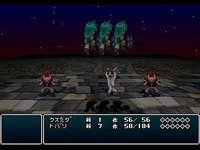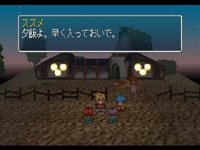|
|

|
PLATFORM
|
PSX
|
BATTLE SYSTEM
|

|
INTERACTION
|

|
ORIGINALITY
|

|
STORY
|

|
MUSIC & SOUND
|

|
VISUALS
|

|
CHALLENGE
|
Moderate
|
LANGUAGE BARRIER
|
High
|
COMPLETION TIME
|
20-40 Hours
|
|
OVERALL

|
+ Simple and effective battles
+ Very expansive backstory
- Visuals are hit or miss, mostly miss
- Voice acting is often drowned out by BGM
- Highly limited exploration
- Menus can be somewhat obtuse
|
Click here for scoring definitions
|
|
|
This may be one of the trickier games I've ever reviewed. I found Wing of Alnam in a used media store for about a dollar, and at first glance that's about what it's worth. Having actually played the game from beginning to end, I can say that it eventually grows on you.
The story is a good place to start. This game is a direct sequel to Fang of Alnam, a PC-Engine title which would be ported to become one of the first RPGs for the PlayStation. Between that game's cataclysmic finale and the events of Wing, a full fifty millennia have passed — much of it spent with the human race in suspended animation. The game plays this up a lot, with the original cast popping in at odd times, bizarre plot twists coming out of left field, and far too many iterations of the phrase "Remember that one time 50,000 years ago?"
Back in the present day, things aren't looking so good. The descendants of the survivors of humanity have built new nations amidst the wreckage of a world turned literally on its side (the aforementioned cataclysm involved a ninety degree shift in the axial tilt), and a second wave of more recently awakened survivors have managed to integrate themselves without attracting attention. The nation of Maya is up to something, though. Without any real explanation its military is surveying the continents, taking stock of the world's condition, and laying plans. Two orphans from the middle of nowhere get mixed up in one of these plans, and find themselves on a whirlwind tour of the planet — all while searching for lost relatives, making new friends, and generally brow-beating each other for no good reason. Also, an insane ancient warrior has activated the Forest Fang, a gigantic terraforming engine, with the intent of making the world perfect on the third try if necessary.
Battles are simple but involved, with up to four party members facing a number of enemies in turn-based combat. Victories gain the player experience, money, and magic points that can be converted into spells by certain party members. These spells must be crafted outside of battle, and they cover a wide gamut of effects. While some (like the poison and stun spells) are of limited use, the buff and debuff spells are crucial to surviving many of the boss battles late in the game. Also, during the course of battle a gauge will fill up next to a character's name. Each character has a variety of unique skills that use up part of this gauge. Success in this game is definitely not as simple as "press A to attack."
 Triple Trouble Trouncing
Triple Trouble Trouncing
|
|
It should be noted that the battle sprites are among the best graphics in this game. Both allies and enemies are clearly drawn and the battle animations are top-notch for the time. Unfortunately, the game's environments are awful muddles of early PSX-era 3D graphics. The world map and the dungeons have rotatable camera angles, but the towns do not — mainly because the buildings are actually 2D popup facades, most of which are just there as scenery. Navigating an area can be difficult even when using the L1 button to superimpose a map over the screen. In dungeons even that is unavailable, which makes for some very annoying levels. One other point is that the player must press the circle button to move through doorways or otherwise transition between areas. Most entrances in towns or dungeons are marked with off-color squares in front to let the player know that entry is even possible.
Wing of Alnam has some good movie sequences, but only in two spots: once before the final level, and then everything that comes after the final boss at the end of the second disk. The game's third disk exists solely to house climax scenes, credits, and epilogue video. Cut-scenes throughout the majority of the game are significantly less advanced. Mostly they are just one or two static screens with a few extra frames to simulate motion — the animated equivalent of stop-motion photography. It's the sort of thing one might expect from a Super Famicom title.
The game's soundtrack is firmly rooted in the 16-bit generation, but unfortunately Wing of Alnam also tries to include voice-acting. The acting is good, but the way it blends with the background music is not. As most of the male actors use that low, faux-gruff, agressively macho voice tone common to Japanese theater, the background music makes it hard to tell what they are saying, or if something is being said at all in the extreme cases. A complete lack of subtitles only makes it harder to keep up with the convoluted plot.
 3D is overrated.
3D is overrated.
|
|
Wing of Alnam's interface has its own share of problems. Item and skill descriptions are not displayed automatically. Instead the triangle button must be held constantly to keep this option toggled. Like the L1 map function, this toggle is not clearly marked in-game, and without the manual it may be a while before the player even notices that it's available. More worrisome is how on the first disk some menu frames, like party roster or spell inventory, may be cut off halfway through. This even happens in battles, making it hard for the player to know just how many charges of a spell might be left.
And then there's the world map. The world of Alnam is effectively split into a series of square zones, with borders that the player cannot cross even if they are contiguous with another zone. The only crossing points are in towns, which often form choke points for the story. Very rarely is the player allowed to backtrack at all. One thing that's done right, however, are enemy encounters, which show up as icons on the map. Enemies can be dodged, can sneak attack, and can even be caught sleeping if it's nighttime. Multiple enemy icons can even be engaged at the same time for extended battles.
Looking back, it's obvious that the developers at Right Stuff wanted to make a game like the 16-bit titles they loved. The plot's tendency to split the party and show everyone taking different paths to the goal is similar to Final Fantasy VI. The battle system looks a lot like the one in Lufia II. And the plot presages many Tales titles with its weird twists and turns about ancient civilizations and hard-light carbon copy people. This is a game that tried to do a lot, only to come out marginally better than an RPGMaker title. Still, Wing of Alnam possesses this odd synergy that kept me going to the end. To be honest, I liked it, and while it never ended up being an awful game, it just couldn't be as good as it wanted to be.
Review Archives
|









